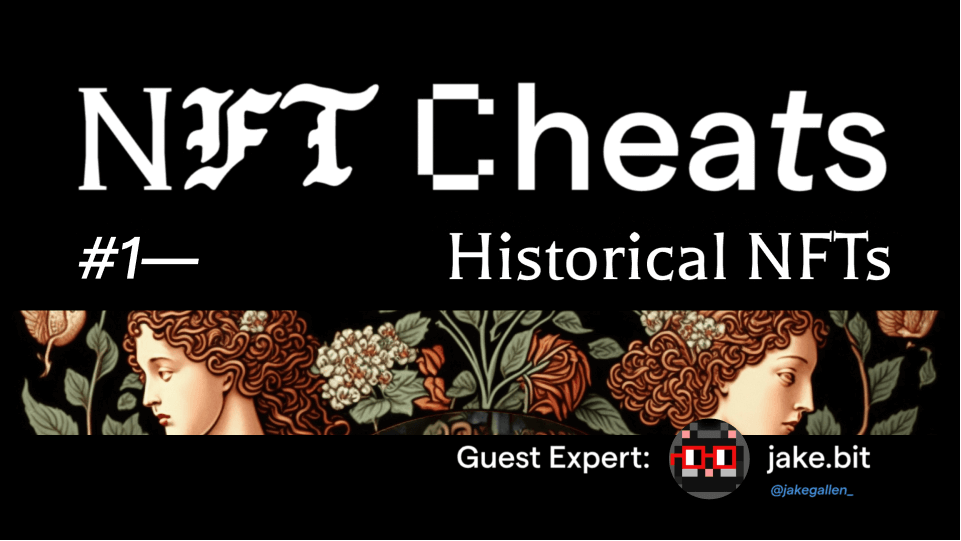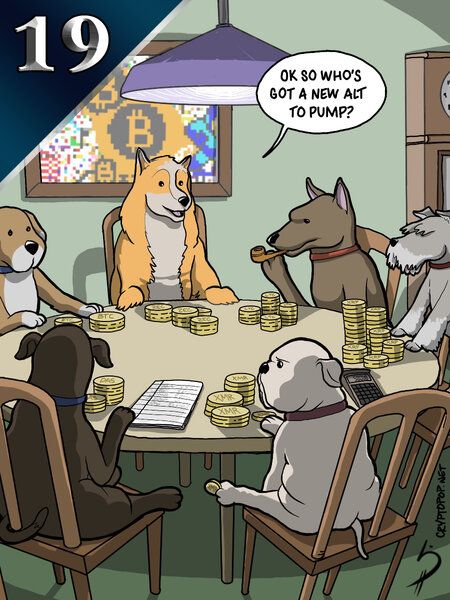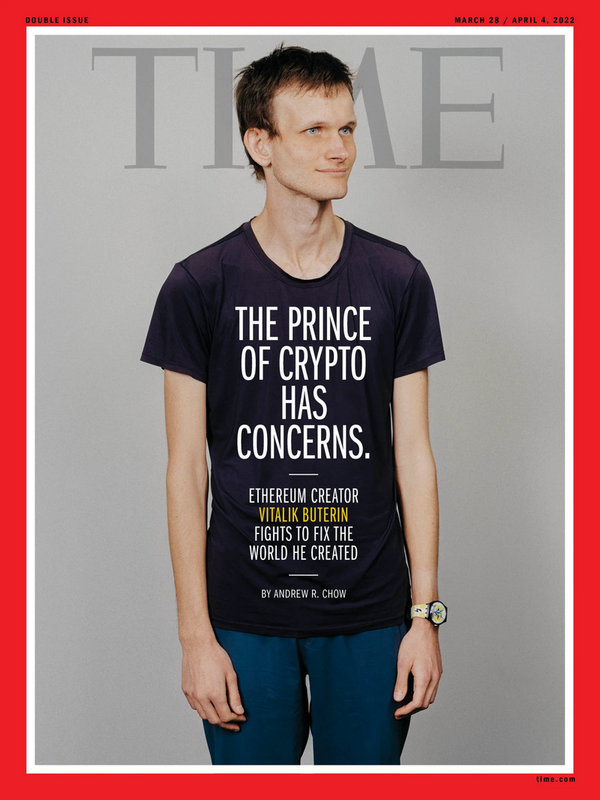Your cheat sheet for... Historical NFTs
NFT space may seem like a jigsaw puzzle. NFT Cheats is a series of newsletters that helps you put the pieces together.

It’s called NFT Cheats because each newsletter is designed as a cheat sheet that will bring you up to speed on a given niche within the NFT space.
Historical NFTs are the first subject in the series.
To put together a cheat sheet on historical NFTs, we talked to jake.bit — an NFT historian who also runs Emblem Vault, a project that allows trading historical NFTs and assets across blockchains.

After graduating from UNLV in 2015, Jake went straight into entrepreneurship. His first business was an antique store that he ran with his father.
Jake got into crypto in 2016. In 2018, he lost everything through an altcoin rug and started all over, discovering NFTs towards the end of 2020. Since then, he’s spent most of his time researching the history of NFTs, which he considers a natural extension of his IRL experience in antique trading.

Before we jump into it, here’s a boring, yet essential disclaimer; DO NOT treat any of the information below as financial advice, and do your own research (DYOR) before buying into any asset.
The interview has been edited and condensed, meaning the content below is attributed to the guest expert, but shouldn’t be treated as a direct quote.
What Historical NFTs are 🏺
Historical NFTs are assets whose innovation, culture and timestamp are acknowledged within the community.
The general timestamp that most of the community has agreed on is the 2011-2019 period. However, historical NFTs is actually a broader term that takes several factors into account. It’s not just the date of mint.
For example, the first AI NFT was created in 2018. The first generative NFTs began with Cryptopunks in 2017.
They weren’t technically some of the first NFTs ever minted on a blockchain, but they were first in their respective areas - and hence have more cultural significance than other NFTs that might have been created much earlier.
How NFTs first appeared 🕰️
The very first NFT was registered on April 21st, 2011, on a blockchain called Namecoin, which was a Bitcoin fork and the first altcoin.
Namecoin enabled a registry of .bit domains, similarly to what ENS are doing with .eth domains.
Those .bit domains were technically NFTs - nonfungible tokens stored on a blockchain - but the term NFT was not used until 2018 when the ERC-721 standard launched on Ethereum. Before that, NFTs were referred to as blockchain collectibles, crypto art and other terms.
The birth of terms ‘historical’ NFTs and NFT archeology, in turn, can be traced back to March 12, 2021.
At the time, an abandoned 2017 NFT project MoonCats was being rediscovered by the community, and some people came up with instructions that allowed anyone with a Ethereum wallet to 'rescue' a MoonCat.
Several other NFT projects, such as Curio Cards and ETHERIA, were then similarly rediscovered within just four days. That started a wave.

The group of people who were actively looking through old contracts on etherscan and researching across different blockchains to find other abandoned NFTs started calling themselves NFT archaeologists.
What NFT archeologists do 🦕
When NFT archeologists find an abandoned smart contract and start bringing it to life (to make the project usable and tradeable), it’s called excavation.
During the excavation process, there are a number of things NFT archaeologists have to diagnose: Is the smart contract available to mint? Is there a previous owner who has a key to reopen that contract? Are there any available tokens? Where is the IPFS hash, or were the images stored on a private server?
Most of the time, the original creator cannot be reached, so a lot of these Historical NFT projects are community-run.
There’re also NFT historians, people who are not necessarily tech-savvy but are willing to put a lot of effort into researching early NFT projects, helping to define the timeline and assess their cultural significance.
What makes Historical NFTs rare 🦄
There's no trait rarity system for most of early NFT projects. It’s something that was first popularized with CryptoPunks, which had about 20 different traits that were randomly combined.
Besides, a lot of these early collections were essentially free, or cost a very small amount of money to mint.
So their rarity had to be essentially determined by the community. Meaning there had to be a lot of timelines, a lot of content on how people view these NFTs.
And that’s where NFT history comes into play.
To explain this, let’s take a closer look at Cryptopunks. As you might know, there’s V1 and V2 Cryptopunks.

The first Cryptopunks had an exploit where a user could buy any Cryptopunk and then revert that transaction and get their money back.
To fix that, Larva Labs — the company that created Cryptopunks — had to create an identical collection with a revised smart contract, and then airdrop those V2 Punks to the original Cryptopunks owners.
Despite technically being the second, V2 are much more valuable than the V1s in terms of the actual price — by about a 10x multiple today.
So although the V1s have the better timestamp, which some of the historical NFT people prefer, the culturally significant component of the V2s, where the community stayed together for four years until their NFTs really blew up, is why they're so valuable.
The situation in which the culturally significant component of a project is more valuable than the timestamp has become very common.
One of the other main drivers of value for historical assets is scarcity.
If you go to pre-ERC-721 times, you'll have probably about less than two million total supply. And if you looked into 2022 alone, there were over 200,000 NFT contracts deployed, each containing up to tens of thousands of NFTs. So you're probably minting like a hundred to a thousand X more NFTs in one year than that exists within the entire Historical NFT class.
But, if I had to put on my antique store owner hat (which I actually had before!), there are still a lot of old NFTs that will end up being pretty much valueless and are essentially yard sale items. If you look at ancient items IRL, not all of them end up being the equivalent of Vincent Van Gogh paintings or ancient Aztec pottery. Same logic applies to historical NFTs.
Most people believe that historical NFTs just need a passive management system, which basically means that they need to simply exist, because they represent art.
What NFTs might become ‘historical’ later 🌾
Back in 2021/beginning of 2022, some of the bigger archaeologists who had larger payrolls started buying up a bunch of assets from 2020 and 2021 — sort of filling the gap in between first PFP collections and BAYC — and calling them historical.
You could say it caused a lot of backlash, because that was a timestamp maximalist approach that overlooked other aspects.
But the pre-Bored Apes PFP collections would be one possible category for future ‘historical NFTs’.
I also look for emerging NFT asset classes and try to determine which may be either culturally/historically significant or innovative. Music NFTs is one that I think will have a large market cap.
There are also more speculative concepts, i.e. first omnichain NFTs that can be transferred between blockchains.
To give you another example, I bought the Vitalik’s issue for Time magazine as an NFT when it came out. I figured if Time magazine was trying to revolutionize writing NFTs, that one could be considered historically significant.

The main difference and the main driver which I try to tell a lot of people about who enter the space: Historical NFTs is a pure collector's community.
If you try to come in and flip these assets, you are going to get rekt because most of the people who are buying Historical NFTs are sending it to their vault and they're probably never going to sell it. And that's just what encapsulates the community.
Where to start with Historical NFTs 🏁
The best way to get started with NFTs right now is oldnft.com. It lists out every asset from 2011, to 2018 and the emergence of ERC-721, and provides links with general information.
If you're a beginner and you don't want to navigate through Emblem Vault (which is where I work) because there is a technical hurdle to it, I would go and look for the 2017 assets that emerged on Ethereum. Those are culturally significant and tend to have a pretty low value entry price.
In terms of specific projects that are beginner-friendly, I’d cut it down to MoonCats, Curio Cards and Punks, both V1 and V2, although V2s are far from affordable. So cats, art and PFPs.
5 Historical NFT people to follow 🎭
- jake.bit (@jakegallen_)
- Leonidas (@LeonidasNFT)
- adammcbride (@adamamcbride)
- White🐰Rabbit1111 (@WRabbit1111)
- Blackstar (@BlackstarXXI)

